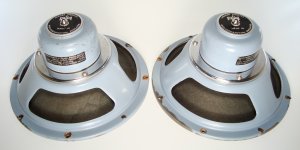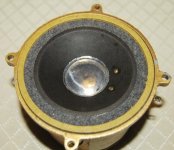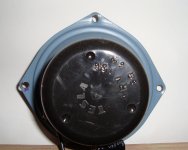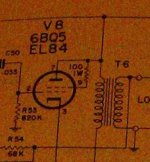Probably best to experiment. Treat the capacitor as a fixed treble tone control.
So this is essentially a notch filter? Would seem contrary to what little I know (of course, the volumes I don't know outweigh any small insights I think I might have). If there was a full tone circuit at the front-end prior to the power amplifier why would the designers attempt to modify HF output at that stage of the design? Is this what the other fellows were inferring about the cap acting as an oscillation filter? Are you fellows talking about the same thing but saying it differently?
No, not a notch but a roll-off. I think I read somewhere that part of the idea is that a simple pentode output produces lots of third-order distortion which can sound shrill, so rolling off the treble can compensate for this (and reduce the third harmonic which a radio speaker might be able to reproduce to a certain extent). Many radio sets roll-off at somewhere around 5-10kHz.
It is possible that by reducing the OPT HF resonance frequency the cap also aids stability, by bringing the OPT phase shift down into a region where the first stage does not produce so much phase shift. Your diagram was difficult to read: what are the feedback component values?
We are not talking about the same thing but saying it differently. We may be talking about two different actions of the same component, but then it might be unclear which action the original designer was after.
It is possible that by reducing the OPT HF resonance frequency the cap also aids stability, by bringing the OPT phase shift down into a region where the first stage does not produce so much phase shift. Your diagram was difficult to read: what are the feedback component values?
We are not talking about the same thing but saying it differently. We may be talking about two different actions of the same component, but then it might be unclear which action the original designer was after.
As I said, it appears to be a standard 1950s radio receiver audio circuit, doubled up for stereo. Grounded cathode triode, followed by pentode SE output stage, with a little NFB which probably does not do very much. Probably a few watts output, at a few percent distortion, with a limited frequency response. If you like its sound, use it as it is (at least it won't suffer from crossover distortion!). If not, build a proper audio amp.
I've heard far worse, especially at the commercial level available here in the under $800 ( £490?) category--mostly Chinese manufactured with pretty little blimking LEDs and deliberately concealed light irons)...The OTs on my little amp for example are about 2.5 lbs. ea.
At present I believe it will make a great learning amplifier for someone like me on a severely strapped budget in order to develop some knowledge about Tube Audio while observing the workings of an example in hand.
The enclosure I salvaged this amp from included some Philips 9710 FR drivers.
I will build a "proper" amplifier in due course, thanks to insight provided by you and others here at DIY Audio willing to suffer my elementary questions as I develop some confidence.
I did hook this little SE amp to my Wharfedale SFB/3s today...it sounded quite good...IMHO...reproducing difficult lower register Pipe Organ passages, as well as lovely mid vocals and shimmering HF cymbals.
I've heard a lot of poo-pooing here on DIYaudio regarding vintage loudspeakers, drivers and the like..the blather seems to go that modern manufacturing materials, technology and CAD programs would easily best anything the old fellows put out...I think the same might be occurring here with this little amp.
Like you, I'm certain there are better topologies to be constructed but for an investment of less than $17.00 Canadian dollars which includes re-doing the caps and installing a volume pot it will take some doing to appreciably best it at anything under several hundred $$$$$ in expense, given today's DIY parts prices.
So I'm getting great enjoyment and bang for the precious few dollars available to me.
At present I believe it will make a great learning amplifier for someone like me on a severely strapped budget in order to develop some knowledge about Tube Audio while observing the workings of an example in hand.
The enclosure I salvaged this amp from included some Philips 9710 FR drivers.
I will build a "proper" amplifier in due course, thanks to insight provided by you and others here at DIY Audio willing to suffer my elementary questions as I develop some confidence.
I did hook this little SE amp to my Wharfedale SFB/3s today...it sounded quite good...IMHO...reproducing difficult lower register Pipe Organ passages, as well as lovely mid vocals and shimmering HF cymbals.
I've heard a lot of poo-pooing here on DIYaudio regarding vintage loudspeakers, drivers and the like..the blather seems to go that modern manufacturing materials, technology and CAD programs would easily best anything the old fellows put out...I think the same might be occurring here with this little amp.
Like you, I'm certain there are better topologies to be constructed but for an investment of less than $17.00 Canadian dollars which includes re-doing the caps and installing a volume pot it will take some doing to appreciably best it at anything under several hundred $$$$$ in expense, given today's DIY parts prices.
So I'm getting great enjoyment and bang for the precious few dollars available to me.
Last edited:
What people have told you about the old speakers is completely true. Loudspeaker science was pretty young back then, and not much of that science made it to the manufacturing floor. Speakers in most old radios and TVs, and even hi-fi's from the 40's and 50's sound silly today.I've heard a lot of poo-pooing here on DIYaudio regarding vintage loudspeakers, drivers and the like..the blather seems to go that modern manufacturing materials, technology and CAD programs would easily best anything the old fellows put out...I think the same might be occurring here with this little amp.
And that may be another reason for the hi frequency filter on the output anode; to calm down some shrieky sounding speakers, which were pretty darn common. I have a few of those "hi-fi" console speakers kicking around and they do sound "silly".
..todd
What people have told you about the old speakers is completely true. Loudspeaker science was pretty young back then, and not much of that science made it to the manufacturing floor. Speakers in most old radios and TVs, and even hi-fi's from the 40's and 50's sound silly today.
And that may be another reason for the hi frequency filter on the output anode; to calm down some shrieky sounding speakers, which were pretty darn common. I have a few of those "hi-fi" console speakers kicking around and they do sound "silly".
..todd
Sorry Todd, I should have been clearer, the thread I was referring to was in regard to speakers like Western Electric, Altecs, etc...not the dreadful stuff usually found in consoles...there are exceptions, of course, like the loudspeakers that came with this amplifier's housing...Philips 9710 FRs, which are highly regarded vintage drivers being used in many DIY enclosures.
I disagree about the old speakers. Aside from magnet structure, nothing has appreciably changed.
The science has not changed, it was used to develop those speakers.
Sure you have CAD to design little boxes to keep your wife from yelling at you, but don't mistake this for an improvement, it's purely compromise.
My Jensen's are neutral sounding, it's hard to tag it with a sound, it simply reproduces what is feed.
One might argue that complex crossovers and other gimmicks ruin the unadulterated sound.
I run full-range Jensen's all around, only a modest first-order filter to protect the vintage Tesla tweeter.
Hook those old speakers up to a contemporary design amplifier and you might be in for a surprise. These old speakers with paper surrounds are much more agile then most modern speakers with heavy cones.
Sure you could add a subwoofer to help with modern music or home theater, the same thing goes for modern speakers though.
I have not heard a modern 10" or 12" cover as much of the audio band with as much control and dexterity as these old Jensens.
Modern 10" or 12" drivers are usually just a "woofer" and can only do a limited bandwidth well. They are too thick and sluggish, need huge amounts of current to get moving, texture is lost in the ruckus.
It's hard to imagine how two people can have such polarizing views on things.
The reality is the mid twentieth century was the golden era for audio. It has taken a commercial downturn since then.
I think DF96 has it right, it's just there to take the edge of AM broadcasts, kinda like a Dolby noise reduction of the day, remove the background hiss to make it sound quiet and natural.
Silly, like a Fox.
I actually don't mind this myth being perpetuated, it means I can get all the wicked fullrangers I want for peanuts, or just the shells.
Just keep it a secret. Most things in audio have come full circle.
The science has not changed, it was used to develop those speakers.
Sure you have CAD to design little boxes to keep your wife from yelling at you, but don't mistake this for an improvement, it's purely compromise.
My Jensen's are neutral sounding, it's hard to tag it with a sound, it simply reproduces what is feed.
One might argue that complex crossovers and other gimmicks ruin the unadulterated sound.
I run full-range Jensen's all around, only a modest first-order filter to protect the vintage Tesla tweeter.
Hook those old speakers up to a contemporary design amplifier and you might be in for a surprise. These old speakers with paper surrounds are much more agile then most modern speakers with heavy cones.
Sure you could add a subwoofer to help with modern music or home theater, the same thing goes for modern speakers though.
I have not heard a modern 10" or 12" cover as much of the audio band with as much control and dexterity as these old Jensens.
Modern 10" or 12" drivers are usually just a "woofer" and can only do a limited bandwidth well. They are too thick and sluggish, need huge amounts of current to get moving, texture is lost in the ruckus.
It's hard to imagine how two people can have such polarizing views on things.
The reality is the mid twentieth century was the golden era for audio. It has taken a commercial downturn since then.
I think DF96 has it right, it's just there to take the edge of AM broadcasts, kinda like a Dolby noise reduction of the day, remove the background hiss to make it sound quiet and natural.
Silly, like a Fox.
I actually don't mind this myth being perpetuated, it means I can get all the wicked fullrangers I want for peanuts, or just the shells.
Just keep it a secret. Most things in audio have come full circle.
Just for the record Alvis....I'm pretty much in complete agreement...I respect what some of the new drivers do and how they do it...but at those prices? I have nothing but vintage drivers and loudspeakers...I'm a little selective now...Goodmans, Richard Allans, Philips, EVs, Jensens. etc. but bang for the buck they'll more than hold their own against new drivers costing 100s of times more. And like you, that's where I get the most satisfaction from....I'd expect a $1000 or more driver to sound good...it had better...it's those old somebody-else's cast-offs that give the thrill.
Yep, it seems confirmed that those .001 caps are to take the edge off HF's , I just don't see why that wouldn't have been engineered on the pre-amp section of this chassis, which was a stand alone plug-in component. with full tone controls. Bass/Treble/Scratch Filter/ etc instead of the power amp end of things.
Yep, it seems confirmed that those .001 caps are to take the edge off HF's , I just don't see why that wouldn't have been engineered on the pre-amp section of this chassis, which was a stand alone plug-in component. with full tone controls. Bass/Treble/Scratch Filter/ etc instead of the power amp end of things.
I just don't see why that wouldn't have been engineered on the pre-amp section of this chassis, which was a stand alone plug-in component. with full tone controls. Bass/Treble/Scratch Filter/ etc instead of the power amp end of things.
The power amp may have been used in different applications, without tone controls, or perhaps the amplifier develops it's own surplus of high frequency content.
You are the first person I have ever heard mention the R&A's (Richard Allens) Talk about a secret!!!
I have a sweet little blue pair myself, they need repair.
They were my favorite speakers. They need a re-coning, the screw transferred some rust onto the surround and some cracking has developed.
They still sound fine, I just don't want to damage them should some uneven tension develop across the surround, may scuff the voice coil.
Some of the finest speakers to come out of England.
Last edited:
Not to go off-topic on ya, but here are the little beauties.
Another little gem that sound good are those Tesla ARO-666.
Yes an entire other, but interesting, topic paper cone tweeters, I have a set of the Wharfedale Super3's with big Alnico Motors that I think are the cats pyjamas, I have a set of Tesla Tweeters much like yours but blue baskets if I recall.
I can just imagine if we started a thread about paper cone tweeters here
 !
!As for going off thread....haven't followed one yet here at DIYaudio that doesn't veer or branch off...keeps it fresh..don't you agree?
Attachments
Last edited:
I agree, and yes I do have a little blue pair of Tesla alnico paper-cone tweeters.
I have tried 6 or 7 other pairs of paper-coned tweets, but these ones stand out from the crowd.
Hard to believe paper cone can make such a "crystal" sound.
They sound much better then they are suppose to, such audacity.
Yours do look very strong, nice basket too.
I have tried 6 or 7 other pairs of paper-coned tweets, but these ones stand out from the crowd.
Hard to believe paper cone can make such a "crystal" sound.
They sound much better then they are suppose to, such audacity.
Yours do look very strong, nice basket too.
Attachments
You mentioned...
Well...
I don't know if this is a Bad Idea, but you could short out those .001uF capacitors between the EL84 pin 7 and B+. Just to see what that sounds like. It might be better, it may well be worse. Just tack solder a wire across it, from one terminal of the cap to the other. Obviously, be careful not to damage anything, and make sure the wire is attached well enough. If the amp sounds horrible that way, remove the wire.
You could also try triode-wiring the EL84's, just for fun. It's a relatively safe experiment, and easy enough to put back to stock if you don't like it. Here's how:
Find a couple of 1W resistors in any value from 100R to 470R. Heck, you could use 1k if that's all you have around. 1/2W resistors would probably be just fine.
Disconnect EL84 pin 9 from the B+ supply.
Connect the resistor from pin 9 to pin 7 on the EL84.
Pin 7 remains connected to the "top" of T6 (the output transformer).
In this case, you probably should short out the .001uF cap from pin 7+9 to B+. Or maybe you can leave it in. I don't know if the value would have to be figured differently (triode operation will change the internal resistance of the EL84, which is probably part of the filter).
Then you'd have a single-ended triode amp! It'll probably only make 2 watts per side, but you might like it.
Next thing you know you'll be dreaming about rewiring the amp with silver wire, or buying Jensen paper-in-oil coupling caps, or scrounging around for motor run capacitors to replace the electrolytics.
I doctored your schematic to show the change.
--
thoughts about whether this circuit is tweakable, or worth tweaking.
Well...
I don't know if this is a Bad Idea, but you could short out those .001uF capacitors between the EL84 pin 7 and B+. Just to see what that sounds like. It might be better, it may well be worse. Just tack solder a wire across it, from one terminal of the cap to the other. Obviously, be careful not to damage anything, and make sure the wire is attached well enough. If the amp sounds horrible that way, remove the wire.
You could also try triode-wiring the EL84's, just for fun. It's a relatively safe experiment, and easy enough to put back to stock if you don't like it. Here's how:
Find a couple of 1W resistors in any value from 100R to 470R. Heck, you could use 1k if that's all you have around. 1/2W resistors would probably be just fine.
Disconnect EL84 pin 9 from the B+ supply.
Connect the resistor from pin 9 to pin 7 on the EL84.
Pin 7 remains connected to the "top" of T6 (the output transformer).
In this case, you probably should short out the .001uF cap from pin 7+9 to B+. Or maybe you can leave it in. I don't know if the value would have to be figured differently (triode operation will change the internal resistance of the EL84, which is probably part of the filter).
Then you'd have a single-ended triode amp! It'll probably only make 2 watts per side, but you might like it.
Next thing you know you'll be dreaming about rewiring the amp with silver wire, or buying Jensen paper-in-oil coupling caps, or scrounging around for motor run capacitors to replace the electrolytics.
I doctored your schematic to show the change.
--
Attachments
I don't know if this is a Bad Idea, but you could short out those .001uF capacitors between the EL84 pin 7 and B+. Just to see what that sounds like.
You may want to rethink this.
Thanks,
Chris
You may want to rethink this.
Thanks,
Chris
Ok Chris...what are your concerns regarding this suggestion?
I have nothing but vintage drivers and loudspeakers...I'm a little selective now...Goodmans, Richard Allans, Philips, EVs, Jensens. etc. but bang for the buck they'll more than hold their own against new drivers costing 100s of times more.
Sorry, I didn't realize you were kool-ade consumers.
..tj
Sorry, I didn't realize you were kool-ade consumers.
..tj
What does that imply, care to dazzel us with your overpriced speaker collection?
I bet it's super trendy.
...and it's spelled Kool aid.
I thought most folks were friendly here and could have a discussion without name calling.
Todd, I did not have to look long to find this quote by you, "There are few things that pis$ me off as much as meaningless, unhelpful snarky two-word replies. Childish and gutless. But thanks for giving us everything you've got."
So it appears we are dealing with a hypocrite, c'est la vie.
Last edited:
- Status
- This old topic is closed. If you want to reopen this topic, contact a moderator using the "Report Post" button.
- Home
- Amplifiers
- Tubes / Valves
- Determing the reason for mystery? cap in schematic.





